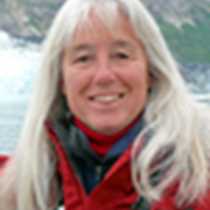Today was one of those extremely unusual days in Glacier Bay National Park; one of only about three or four days out of a summer month that is mostly clear. The Fairweather Mountain Range was out in all its splendor. Mount Fairweather rises 15,300 feet directly up from sea level. Situated between the Pacific Ocean and Glacier Bay, these high mountains are the reason for the existence of so many glaciers in this area. The two ingredients necessary for the production of glaciers are moisture and cold enough temperatures so that precipitation comes in the form of snow and remains year after year. With time and pressure the snow turns to ice. When enough ice collects, it starts to flow slowly downhill and becomes a moving river of ice - a glacier. Many glaciers in Glacier Bay reach salt water and are termed tidewater glaciers. Southeast Alaska is one of only a few places in the world that have this kind of glacier. The creation of Glacier Bay meant an unprecedented retreat of ice: a recession of about 65 miles in little more than 200 years.
Since then, life has been returning to Glacier Bay. The successional process is more rapid than expected. There is now a spruce forest at the mouth of the bay. Moving up bay is like traveling through time. The vegetation thins until there is just bare rock and gravel at the glaciers' termini. Lichens are the first pioneers; they break up the rock, start to form soil, and provide nutrients for herbaceous plants. The first trees are alders, willows and cottonwoods. With the help of bacteria, alders and other plants can take oxygen from the atmosphere and fix it into a form that paves the way for more diverse growth. Hemlocks are now growing in the shade of the larger spruces and will eventually dominate the mature forest. With the establishment of vegetation, animals follow: runs of salmon, colonies of seabirds; mountain goats, wolves, bears, moose, and marmots; seals, sea lions, sea otters and whales. Inevitably, the ice will return and the process will repeat, as it has so many times in the past.




